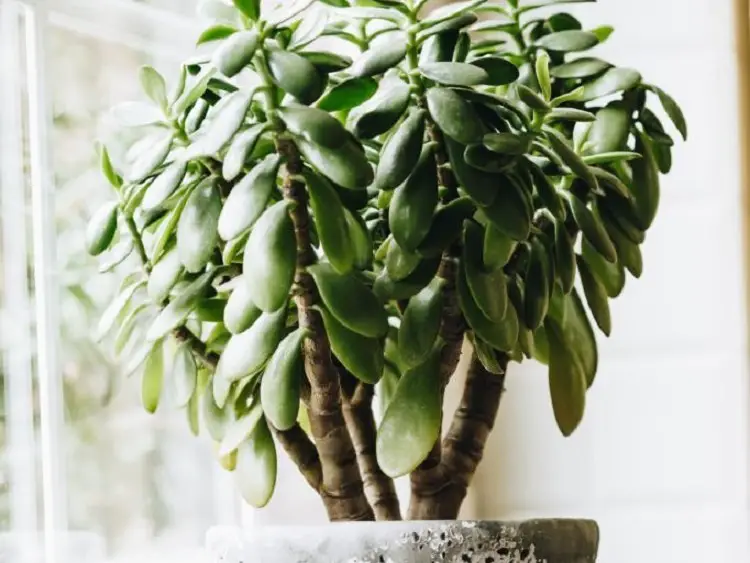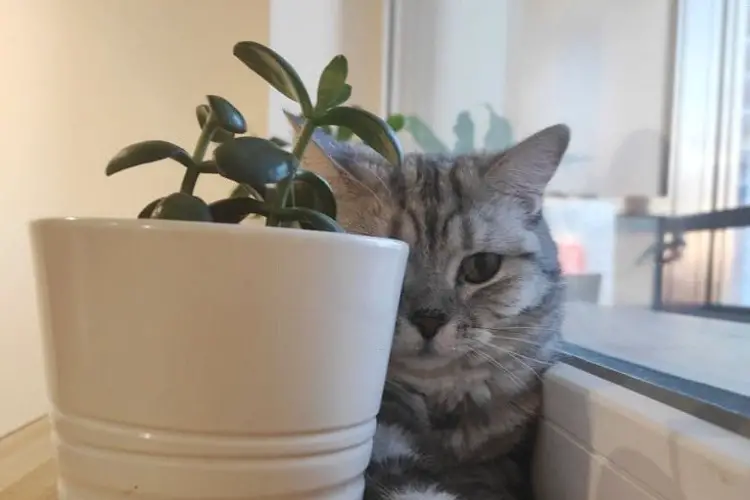Are you one that loves keeping pets like cats, and you have money trees in your house? Now you are puzzled by the thought, “Are money trees toxic to cats”?
The money tree plant is a beautiful ornamental houseplant. To many, it represents good fortune, and many keep it because it is easy to care for.
If you’re considering keeping a money plant for its beauty, it’s important to ensure it won’t harm your cat. You should verify whether the money trees are toxic to cats.
The answer is that the money tree is not toxic to cats. However, if eaten by your cat, there are high chances of stomach upset.
Read on to learn everything you need about money tree plants and what houseplants you shouldn’t have around your home.
The Money Tree Plant: Overview

The money tree plant (Pachira aquatica) is an evergreen plant with broad leaves in Central and South America. It goes by many names, such as Good Luck Tree, Malabar Chestnut, Guiana Chestnut, French Peanut, Saba Nut, Monguba, Pumpo, Provision Tree, and Wild Kapok Tree.
In the wild, this tree can grow up to 60 feet. It is of tropical origin, but when cultivated, it becomes smaller.
The plant has bright green leaves and stems that are braided. Its dangling leaves tend to attract many cats.
If you grow them indoors, these plants can reach 6 to 8 feet when potted.
When cultivated in the house, it is usually good to grow them in full sun to almost full shade and in moist, wet soil.
Why Do Cats Eat Money Trees?
If cats possess one trait, they can be curious and playful, and when they see the money plant, they may not be able to resist the thought of trying to eat it.
Another attractive feature of this plant to the cat is the climbable ornamental trunk. It has thin, flexible trunks.
There are times when three or more trees are planted in one pot with their trunks braided together, and when this happens, know that you have provided an invitation for a curious cat.
Sometimes some cats eat plants for fun. They bite and paw at leaves for the same reason they attack feathery cat toys.
When they do this, know that it is a sign of boredom, and if you want to stop this activity or get your cat happy, try introducing extra playtime with your cat.
Are Money Trees Toxic to Cats?
Your cat eating the leaves or any part of the money plant doesn’t threaten the cat, and your cat’s health is unaffected.
It simply means that the money tree plant is not toxic to your cat, but that doesn’t mean that there are no side effects, and some of the side effects include stomach upset.
If you want to avoid these and other possible effects on your cat, place your money tree in an inaccessible location, such as in a room where you can close the door and prevent your cat access.
Difficulties might be encountered while preventing an outdoor cat from chewing on an outdoor money tree plant, but it is achievable if you apply proactive measures.
Try spraying the plant with a bitter-tasting spray formulated specifically to discourage snacking.
How To Keep Cats Away From Money Trees

There is a thousand-and-one way of keeping your cat away from your house’s plants (money tree).
When you do this, you are trying to cat-proof your potted plant; most times, some of these ways may be challenging.
One of the surest ways to cat-proof your potted plant, especially your money tree, is to use natural substances that repel cats, sprinkle them on your money plants, and watch your cat avoid your potted plant-like plague.
Some natural repellents you can sprinkle on your money tree plant that scares away cats include Mustard powder, pepper, and citrus oils.
You can use cat grass to take your cat’s attention away from your money tree plant.
All you have to do is keep a pot of cat grass that diverts your cat’s attention away from your money tree and give it a better plant to snack on.
What Are The Disadvantages of Cats Eating Money Trees
As much as feeding or snacking on the money tree is not toxic to your cat, there are other reasons you shouldn’t encourage such an act.
One such reason is that it makes your plant more vulnerable and more prone to damage and death, as frequent biting or eating might damage or kill a plant.
There are chances of your cats being harmed by pesticides, fertilizers, and other additives found in and around houseplants.
What To Do When There is Severe Harm To Your Cat
So when severe injury or harm happens or comes to your cat after consuming the money plant tree, you should consult your veterinary doctor and seek professional help and advice.
Though the chances of this happening are very slim, if it happens, seek professional medical advice, and your cat will bounce back to health again and become playful and cheerful as usual.
Houseplants That Are Harmful To Pets
1. Aloe Vera
The Aloe plant has skin-smoothing properties that benefit humans but can harm cats and dogs. If a pet chews on or eats something it shouldn’t, it can irritate its digestive system. This can lead to vomiting, diarrhea, tremors, depression, and a change in urine color..
2. Lily
Wide varieties of lilies are highly toxic; some are for dogs, but most can pose serious health issues like vomiting, loss of appetite, drooling, and lethargy, and some species could even cause kidney failure and death in cats if ingested.
3. Jade Plant
The jade plant, also called rubber or money plant, harms cats and dogs. It can cause various health issues such as vomiting, depression, ataxia (loss of muscle control and coordination), and a slow heart rate.
4. Ivy
Many species of Ivy can pose serious health threats to pets. It’s important to be aware that English Ivy can harm dogs, resulting in symptoms such as drooling, vomiting, diarrhea, and abdominal pain. Devil’s Ivy can also cause oral irritation and difficulty breathing in cats and dogs.
Even growing Ivy in your garden can emit harmful spores that cause a rash and breathing problems if eaten.
5. Dracaena
The Dracaena, or the Dragon Tree, is a sizable indoor plant that can harm cats and dogs if ingested. It may lead to drooling, vomiting, and weakness and can cause cat dilated pupils.
6. Fig
The Weeping Fig, or the Indian Rubber Plant, can harm pets. Contact with the skin can cause irritation and dermatitis, while ingestion can lead to oral irritation, vomiting, and salivation. It’s important to remember this if you have pets at home.
Many more plants can cause severe and mild symptoms if your cat or dog ingests them.
Houseplants that are Safe for Pets
Aside from money trees, there are other houseplants you can have around your home. These include
1. Moth Orchid
Moth Orchids are a favorite choice for many because their flowers last long and bloom all year round. They thrive indoors because they can tolerate a consistent temperature.
2. Spider Plant
For those with less-than-perfect green thumbs, the spider plant is one of the easiest houseplants to keep alive.
These resilient plants can thrive in various environments and often generate “spiderettes” that can be placed in their pots and grown into new plants after being separated from the original mother plant.
Related Post: How To Care For Polka Dot Plant
Final Thoughts
I hope you’ve received a satisfactory answer to your question, “Are money trees toxic to cats”?. While money tree plants are not poisonous to cats if ingested, there is a high risk of stomach upset.
As much as feeding or snacking on the money tree is not toxic to your cat, there are other reasons you shouldn’t encourage such an act.
One such reason is that it makes your plant more vulnerable and more prone to damage and death, as frequent biting or eating might damage or kill a plant.
There are chances of your cats being harmed by pesticides, fertilizers, and other additives found in and around houseplants.

